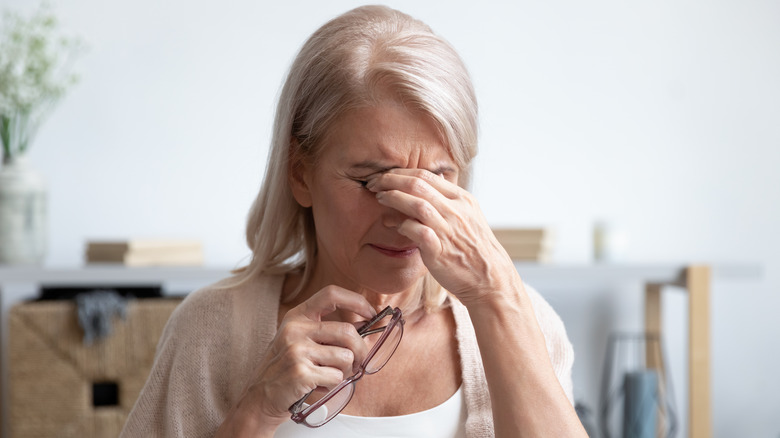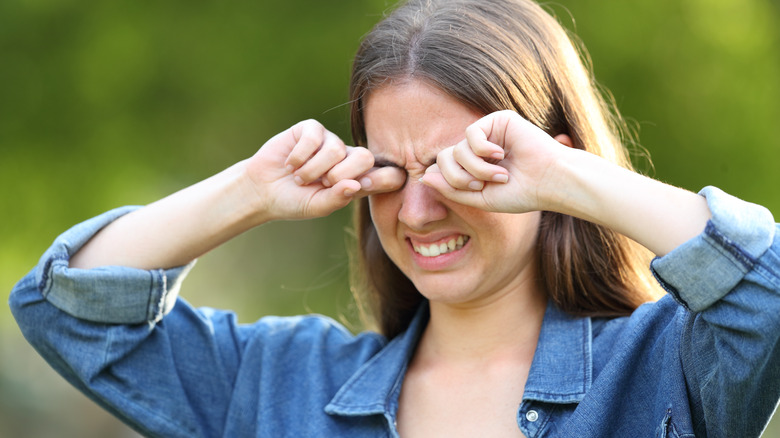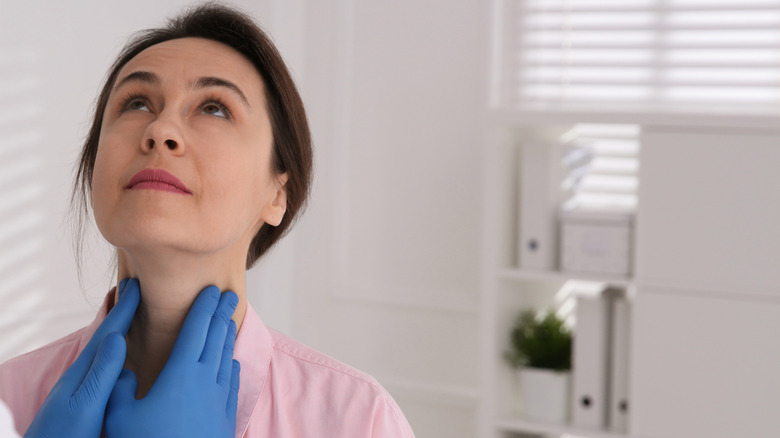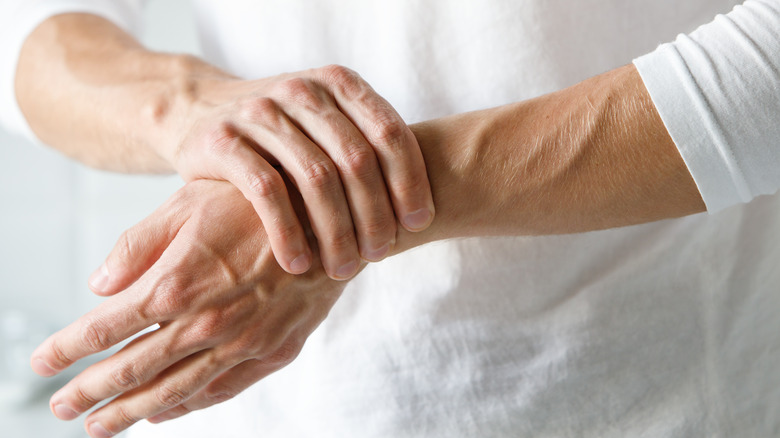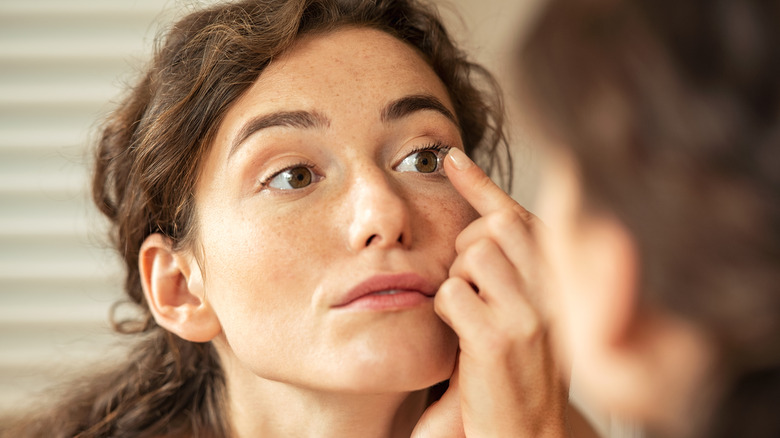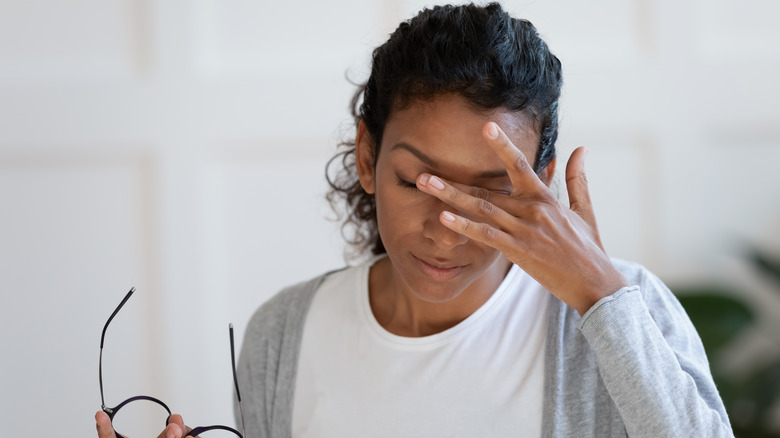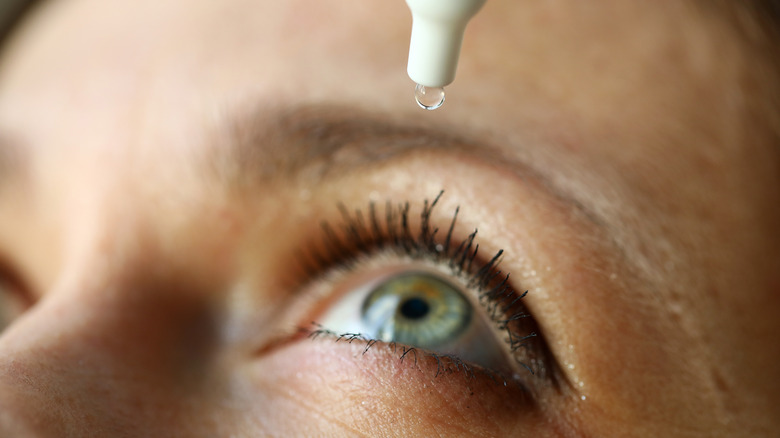Dry Eyes Explained: Causes, Symptoms, And Treatments
At best, itchy, dry, irritated eyes are a nuisance; at worst, dry eyes are painful and can impair your vision (via Mayo Clinic). You either spend hours trying to rub a nonexistent "something" from your eye, or you use copious amounts of eye drops to ease the discomfort. All the while, you wonder what could be causing it.
Dry eyes occur when any or all of the three layers that make up your tear film (fatty oils, aqueous fluid, and mucus) are disrupted, according to the Mayo Clinic. Tear film disruptions can result from a variety of factors. Regardless of their origin, though, dry eyes are a common problem that can cause serious harm if left unmanaged.
According to the National Eye Institute, about 16 million Americans experience dry eye. And without treatment, dry eyes can lead to inflammation, vision loss, and lower quality of life. This is why it's important to recognize the causes and signs of the condition, as well as seek treatment if needed.
Common signs of dry eyes
If you have dry eyes, you know the irritation is hard to ignore. Common signs include burning, itching, and stinging in the eyes (via Mayo Clinic). However, some symptoms of dry eyes are less straightforward than others.
Some people experience dry eyes for a few days or weeks, followed by a few days of overly watery eyes. You may be sensitive to light or have a hard time driving at night. Your vision may blur on occasion or become fatigued. You may even be able to spot dry eyes in the mirror if your eyes are red or you have stringy mucus in and around the eyes, explained the Mayo Clinic.
Oftentimes, dry eyes can be confused with having something in your eye. A person may rub at it for hours, thinking that whatever the object is will dislodge. However, rubbing at dry eyes will only exacerbate the problem (via Atlantic Eye Institute).
Aging
Age-related dry eye affects all parts of the eye and can be either "anatomical or inflammation-induced," explained a study in International Ophthalmology Clinics. One of the reasons why aging causes problems with the eyes is the increasing levels of oxidative stress. As we get older, even if we're healthy, we experience a baseline chronic low-grade inflammation built up from either a lack of antioxidants or too much oxidative stress, according to a report published in the Journal of Ophthalmology. Antioxidants are molecules that come from our diet that inhibit oxidation and reverse the effects of oxidative stress. Oxidation occurs as a result of the body's normal metabolic process.
Dry eyes in older adults can also be caused by a person's abundant usage of prescription medications (aka polypharmacy). Aging is also known to cause a deficiency in your sex hormones, a group of hormones that contributes to the equilibrium of the eye's surface. Not only are dry eyes more prevalent among the older generations, but the results of developing dry eyes also have significant consequences for the person's overall quality of life. The symptoms tend to be more severe and the cost of treating dry eyes more strenuous.
Sjögren's syndrome
Sjögren's syndrome is a chronic disorder that impacts the body's ability to produce moisture, including saliva and tears, according to Cleveland Clinic. Named after Swedish scientist Henrik Sjögren who first categorized the syndrome, the condition can appear on its own or alongside other autoimmune disorders such as rheumatoid arthritis and lupus.
In people with Sjögren's, the body's immune cells attack cells in the tear system and salivary glands. The immune attack on the tear ducts causes decreased tear production and causes chronic dry eye. The reason the body attacks itself is not well understood and could be a combination of environmental factors, genetics, viral infections, and sex hormone imbalances.
The dry eyes and mouth caused by Sjögren's syndrome are often accompanied by joint and muscle pain, dry skin, hoarseness, blurry vision, damage to the cornea, oral thrush, and enlarged salivary glands. Your doctor can help diagnose Sjögren's using blood tests and exams.
Thyroid disease
Dry eyes are sometimes the first sign of thyroid disease, according to WebMD. Both Hashimoto's disease and Graves' disease are autoimmune disorders of the thyroid gland, the first caused by a lack of thyroid hormones and the latter an excess. Although a person with either disease can experience dry eyes, it is more common in people with Graves'.
When a person has thyroid disease, the same antibodies that attack the thyroid can also attack "certain proteins in your eyes" as they are "similar to thyroid tissue," WebMD explained. In people with Graves' disease, in particular, the antibodies attack the eye muscles and connective tissues around the eye causing inflammation and swelling.
The tears that keep our eyes moist are made up of water, oil, and mucus. The oil is produced by small glands in our eyelids and helps the eyes retain water. The water keeps the eyes moist. Unfortunately, thyroid disease may make it so you do not produce enough tears and/or oil. And according to WebMD, treating Hashimoto's or Graves' disease is not enough to get rid of dry eye.
Certain drugs
Aside from polypharmacy, certain drugs may also include dry eyes as a possible side effect. In particular, antihistamines, beta-blockers, acne medications, diuretics, and gastrointestinal disorder medications are all known to affect the eyes (via Everyday Health). Most of these drugs dry out the tear film. For example, antihistamines help to mitigate allergic reactions but decrease tear production. Acne medications reduce oil production to prevent build-up in the skin but may also stop the oil production that keeps the eyes lubricated.
A spokesperson for the American Academy of Ophthalmologists, Dr. John Hovanesian, told Everyday Health that beta-blockers "reduce some of the microcomponents of tears and decrease fluid production [in the eye]." These common heart medications are proscribed often and for conditions related to hypertension, high blood pressure, heart failure, and abnormal heart rhythms.
Dry eye may not seem serious, but Dr. Hovanesian says that "it gets worse as we get older, and it is important to treat and break the cycle of damage that happens to the eye with dryness." A helpful complement to your prescribed drugs would be omega-3 fatty acids. Although omega-3s are better when absorbed through your diet, they may ease dry eye symptoms even in supplement form (via Everyday Health).
Rheumatoid arthritis
Although rheumatoid arthritis primarily affects the joints, one of the lesser-known symptoms is dry eye. Dry eye is a common occurrence in people with rheumatoid arthritis and, according to John Hopkins medical instructor Dr. Ana-Maria Orbai, "can result in an itching, sand-like sensation in the eyes, and redness" (via Everyday Health). Other common symptoms include blurred vision, lack of tears, and excessive evaporation of tears.
Experts speculate that the cause of dry eyes is not a lack of tears but instead due to meibomian gland dysfunction (MGD), according to a study in the Journal of Ophthalmology. The meibomian glands secrete oil into the eye and form the outermost structure of tear film. They also hypothesize that the MGD could be caused by antibodies attacking the meibomian glands the same way they do in thyroid diseases and Sjögren's syndrome. Indeed, many people with rheumatoid arthritis develop secondary Sjögren's triggered by the onset of RA.
Computer use
Certain habits can be responsible for dry eye. People are steadily increasing their time spent staring at screens — from the computers we use at work to the handheld devices we carry around in our pockets. Each day, adults spend about 8.5 hours looking at screens (via HealthPartners). Doctors suggest a max of two hours of screen time outside of work.
A 2018 study compared a group of people who spent 8 hours a day on the computer to a group that spent less than an hour using a screen. The people who spent more time on the computer had significant changes to their tear break-up time. Tear break-up time measures the time it takes for the first dry spots to appear on the cornea after the administration of a topical liquid into the eye.
The study suggests that long hours spent on the computer can increase a person's risk for developing an evaporative-type eye disease, the most common type of dry eye disorder.
Dehydration
A common preventable problem that can contribute to dry eyes is dehydration. Up to 75% of Americans may be chronically dehydrated (via Chicago Sun-Times). This is a problem for the eyes, in particular, as the vitreous body of the eye is 98% water (via Zeiss). Water is also one of the essential parts of our tears. When we do not have enough water in the body, we may experience grittiness, irritation, and, blurry vision in the eyes.
A 2012 study on the correlation between whole-body hydration and dry eye found that people with dry eye often have higher plasma osmolality. Plasma osmolality measures the balance of electrolytes and water in the body. Osmolality increases when you are dehydrated and decreases when you are hydrated. High osmolality levels trigger the release of antidiuretic hormones, which regulate the water levels by controlling how much urine the kidneys put out.
Low levels of water in the body alert the kidneys that it needs to conserve the remaining fluid. The body then pulls water from the less essential systems causing issues with dry mouth, muscle cramps, headaches, dizziness, and dry eyes.
Vitamin A deficiency
Vitamin A can be obtained through your diet. Good sources of vitamin A include dairy products, fish, and liver. You can also get it by consuming beta-carotenes, found in yellow, red, and green leafy vegetables like spinach, carrots, and sweet potatoes, or in yellow fruits like mangos and apricots (via NHS).
It's important to get enough vitamin A for a number of reasons. It protects the surface of the eye, known as the cornea, by keeping it clear. Sufficient levels of vitamin A reduce a person's risk of developing macular degeneration and vision loss (via Healthline). Vitamin A also supports healthy immune system function, which lessens inflammation in the eyes.
Dry eye caused by vitamin A deficiency is called xerophthalmia (via WebMD). Dry eyes are the first symptom of xerophthalmia, followed by more severe vision problems and possibly blindness. When left untreated, vitamin A deficiencies can cause cornea damage, night blindness, and spots on the eyes.
Contacts
Despite significant advances in eyewear technology, contacts are not as popular as one might think. According to a report in Clinical Optometry, as many as 10 to 50% of contact users return to glasses within three years of switching to contacts because they find them uncomfortable. Dry eyes are the most common symptom that causes people to stop using contacts.
A lack of discussion between ophthalmologists and their patients may exacerbate the problem. Some may think they will have to stop using contacts altogether to prevent their symptoms from reappearing, but this may not be the case. Many options exist to mitigate the negative effects of contacts. Additionally, contact lens manufacturers are constantly looking to improve their products. These days, they even make contact lenses specifically for people who suffer from dry eyes (via Healthline).
Scientists are also exploring methods to reduce the friction caused by long-term contact use, as explained in the Clinical Optometry report. A solution of oil and water created to simulate tears can reduce friction, as can the biotherapeutic protein lubricin. Lubricin protects cartilage tissue against the effects of friction between the ocular surface and the eyelids.
Sex
"Women are disproportionately affected by DED [dry eye disease], are diagnosed at a younger age, and experience more severe symptoms compared with men," according to a report in the Journal of Women's Health. Medical experts hypothesize that the disparity could be due, at least in part, to the fact that women are more likely to seek out care for medical conditions than men. However, the fact that more women are diagnosed with dry eyes compared to men could also be closely related to hormones.
Both the levels of sex hormones and hormone cycles "affect ocular structure, functioning, and health," according to the report. Low levels of androgens are the most consistent hormone associated with dry eyes. However, fluctuations in estrogen levels (which occur during the menstrual cycle) are another well-known instigator of dry eye disease.
Women are also more likely to experience dry eyes during menopause due to fluctuating hormones (via WebMD). Hormone replacement therapy (HRT) is a common treatment for menopause symptoms, including dry eyes. However, some women experience worsening dry eyes with HRT. "It does seem that women who take only estrogen are more likely to get dry eye, while those who take a combo of estrogen and progesterone (another female sex hormone) are less likely to get it," explained WebMD.
Treatment
When you first notice your dry eyes, your first instinct might be to reach for the over-the-counter artificial tears, also called dry eye drops. However, some eye drops are not meant to be used more than four times a day, and if you have chronic dry eyes, that may not seem like enough (via Mayo Clinic).
Other ophthalmologist recommendations for preventing dry eye include blinking often, removing makeup at the end of the day, looking up from the computer screen every 20 minutes to give your eyes a rest, and quitting smoking, which is a well-known eye irritant (via Everyday Health).
More serious cases may require a prescription from your ophthalmologist or optometrist. Immune-suppressing drugs could help by reducing the inflammation that is preventing tear production. Antibiotic eye drops are made to reduce the inflammation in the eyelids. Surgery to block up tear drainage holes may be an option to help your eyes conserve the few tears they do make (via Everyday Health). Always consult with a doctor if symptoms persist or worsen.


